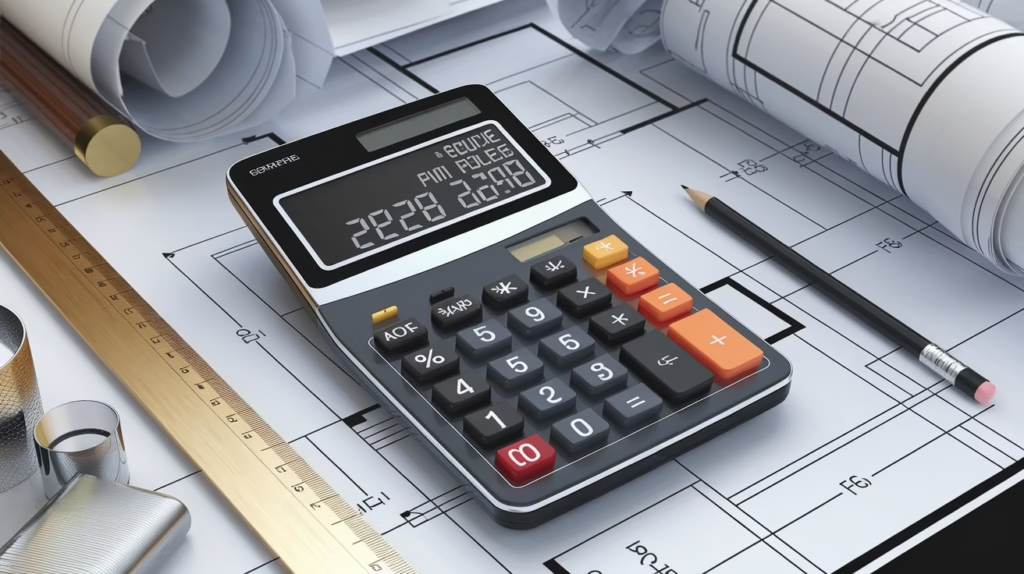Average Cost of a Roof Replacement in USA – 2025
As we approach 2025, homeowners across the nation are increasingly concerned about the costs associated with maintaining their properties.
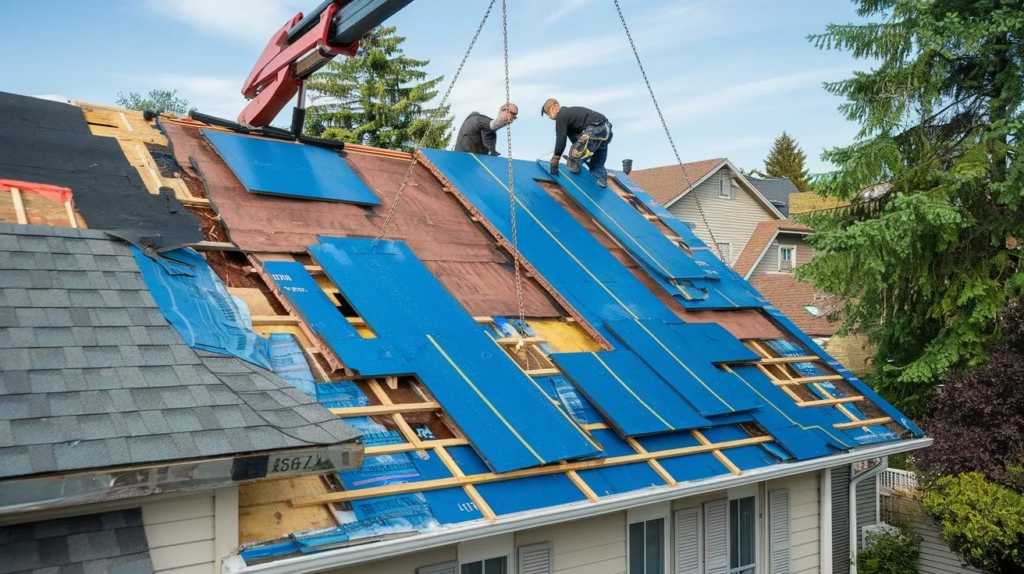
One significant expense that often catches people off guard is roof replacement. Whether you’re planning ahead or facing an immediate need, understanding the factors that influence roof replacement costs is crucial for effective budgeting and decision-making.
A roof is more than just a protective covering for your home; it’s an investment in your property’s value, energy efficiency, and overall comfort. With advancements in roofing technology and an ever-changing market, it’s essential to stay informed about the latest trends and factors affecting roof replacement costs.
Factors Affecting Roof Replacement Cost
The cost of replacing a roof isn’t a one-size-fits-all figure. It varies significantly based on several key factors. By comprehending these elements, homeowners can better prepare for the financial implications of a roof replacement project and make informed choices about their roofing needs.
1. Roof Size and Square Footage
When it comes to roof replacement, size matters – a lot. The larger your roof, the more materials and labor will be required, directly impacting the overall cost. Roofing professionals typically measure roof size in “squares,” with one square equaling 100 square feet of roofing material.
| Roof Size | Approximate Squares | Estimated Cost Range (Asphalt Shingles) |
|---|---|---|
| Small (1,000 sq ft) | 10 squares | $3,500 – $10,500 |
| Medium (1,700 sq ft) | 17 squares | $5,950 – $17,850 |
| Large (3,000 sq ft) | 30 squares | $10,500 – $31,500 |
It’s important to note that these estimates are based on a simple, single-story roof. More complex roof designs or multi-story homes may require additional materials and labor, increasing the overall cost.
2. Roofing Material
The choice of roofing material is perhaps the most significant factor influencing the cost of your roof replacement project. Different materials come with varying price points, durability levels, and aesthetic appeal. Let’s explore some common roofing materials in more detail:
a. Asphalt Shingles
Asphalt shingles remain the most popular choice for residential roofing due to their affordability and versatility. They come in various styles and colors, allowing homeowners to customize their roof’s appearance. Asphalt shingles typically last 20-30 years, making them a cost-effective option for many homeowners.
b. Metal Roofing
Metal roofs have gained popularity in recent years due to their longevity and energy efficiency. They can last 50 years or more with proper maintenance. While the initial cost is higher than asphalt shingles, metal roofs can be a wise long-term investment, especially in areas prone to severe weather.
c. Slate
Natural slate is prized for its beauty and exceptional durability. A properly installed slate roof can last over 100 years. However, this longevity comes at a premium price, making slate one of the most expensive roofing options available.
d. Tile (Clay or Concrete)
Tile roofs offer a distinctive appearance and excellent durability. They’re particularly popular in Mediterranean or Spanish-style homes. Clay tiles tend to be more expensive than concrete tiles but can last longer, with some clay tile roofs lasting over 100 years.
e. Wood Shakes
Wood shakes provide a natural, rustic look that many homeowners find appealing. They offer good insulation properties but require more maintenance than other roofing materials. Wood shakes typically last 30-40 years with proper care.
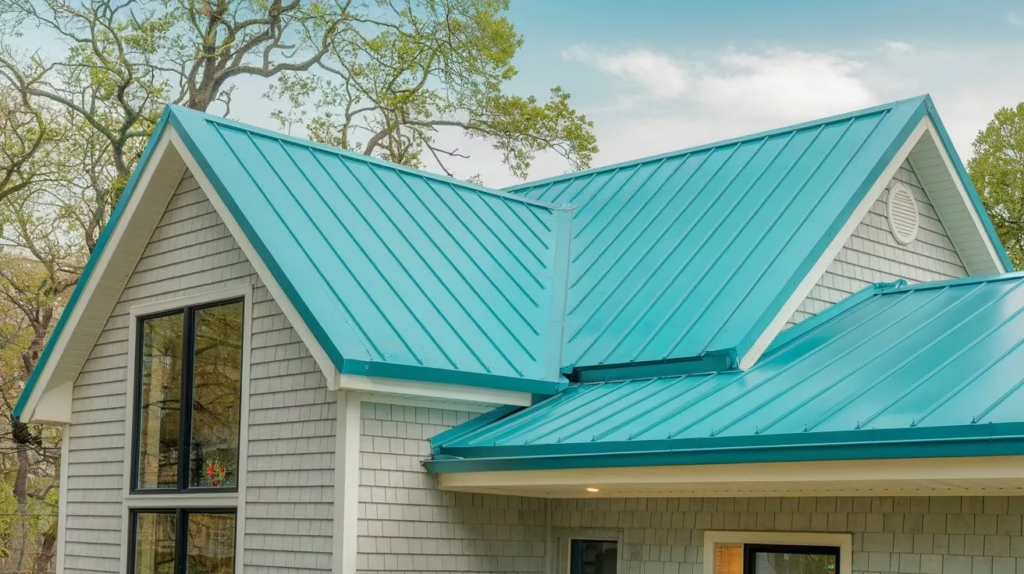
3. Labor Costs
Labor costs constitute a significant portion of your roof replacement budget. These costs can vary based on several factors:
- Local market rates: Labor costs differ from one region to another, often reflecting the local cost of living and demand for roofing services.
- Roof complexity: Steeper pitches, multiple levels, or intricate designs require more time and skill, increasing labor costs.
- Accessibility: If your roof is difficult to access, it may require special equipment or extra safety measures, adding to the labor expenses.
- Removal of old roofing: The cost of removing and disposing of your old roof is typically included in labor costs.
- Seasonal demand: Roofing contractors may charge higher rates during peak seasons when demand is high.
It’s worth noting that while it might be tempting to opt for the lowest bid, quality workmanship is crucial for a long-lasting roof. Investing in experienced professionals can save you money in the long run by reducing the likelihood of premature repairs or replacements.
4. Roof Complexity
The complexity of your roof’s design plays a significant role in determining replacement costs. Features such as multiple slopes, dormers, skylights, and chimneys can increase the project’s complexity and, consequently, its cost. Here’s why:
- Additional materials: Complex roof designs often require more materials to ensure proper coverage and water resistance.
- Increased labor time: Intricate designs take longer to work on, increasing labor hours and costs.
- Specialized skills: Some complex features may require specialized skills or equipment, potentially increasing labor rates.
- Higher risk: Working on complex roofs often involves greater risk for workers, which can be reflected in higher insurance costs passed on to the homeowner.
When budgeting for your roof replacement, consider any unique features of your roof that might add to its complexity and cost.
5. State and Local Laws
Your location can significantly impact roof replacement costs due to varying state and local regulations. These laws can affect your project in several ways:
- Building codes: Local building codes may dictate specific materials or installation methods, potentially increasing costs.
- Permits: Many jurisdictions require permits for roof replacements, adding to the overall project cost.
- Energy efficiency requirements: Some areas have mandates for energy-efficient roofing materials, which can increase upfront costs but potentially lead to long-term savings.
- Disposal regulations: Rules regarding the disposal of old roofing materials can vary, potentially affecting removal costs.
- Insurance requirements: Some states may have specific insurance requirements for roofing contractors, which can influence their rates.
Before embarking on your roof replacement project, it’s crucial to research and understand the local regulations that may impact your costs and choices.
6. Time of Year and Urgency
The timing of your roof replacement can significantly affect its cost. Here are some considerations:
- Seasonal demand: Roofing contractors are typically busiest during late summer and fall, which can lead to higher prices due to increased demand.
- Weather conditions: Certain materials perform better when installed in specific weather conditions, which might limit your options during certain seasons.
- Emergency replacements: If you need an urgent replacement due to severe damage, you might face higher costs due to the immediate need and potential overtime work.
- Off-season discounts: Some contractors offer discounts during their slower seasons (usually winter and early spring) to maintain a steady workflow.
- Material availability: Prices for roofing materials can fluctuate throughout the year based on supply and demand.
If possible, planning your roof replacement during off-peak seasons can potentially lead to cost savings. However, it’s important to balance potential savings with the immediate needs of your home and the weather conditions in your area.
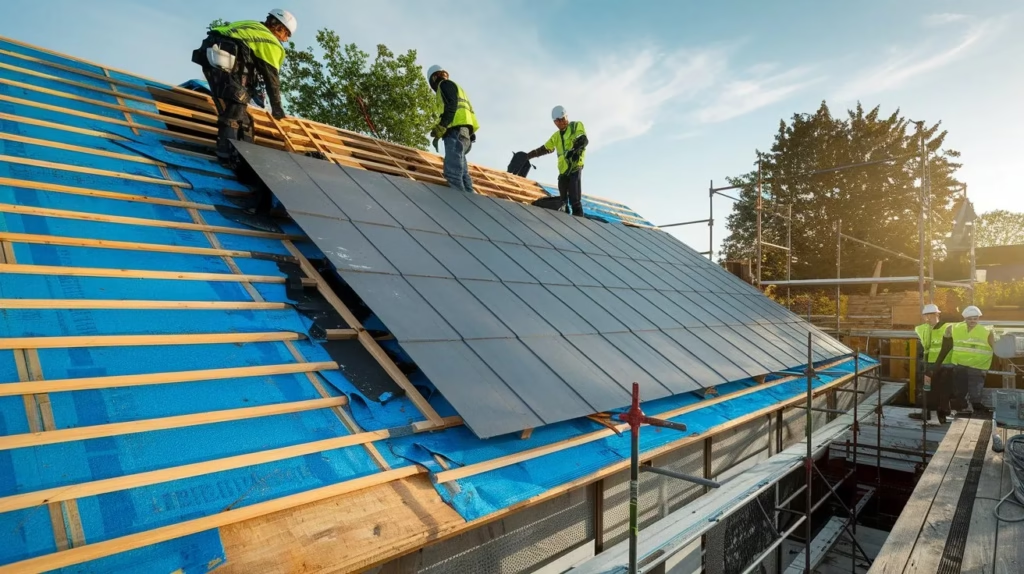
Roof Replacement Cost Estimates
While exact costs can vary widely based on the factors we’ve discussed, having a general idea of price ranges can help in your planning process. Let’s break down the estimated costs by roofing material:
Roof Replacement Cost by Material (per square foot)
| Material | Cost Range (per sq ft) | Average Cost (1,700 sq ft roof) | Lifespan |
|---|---|---|---|
| Asphalt Shingles | $3.50 – $10.50 | $5,950 – $17,850 | 20-30 years |
| Metal | $12 (average) | $20,400 | 40-70 years |
| Slate | $15 – $30+ | $25,500 – $51,000+ | 75-100+ years |
| Wood Shake | $9 – $18+ | $15,300 – $30,600+ | 30-40 years |
| Tile (Clay/Concrete) | $8.50 – $15.25 | $14,450 – $25,925 | 50-100 years |
| Flat Roofing | $2.50 – $9 | $4,250 – $15,300 | 10-20 years |
| Solar | $20 – $40 | $34,000 – $68,000 | 25-30 years |
| Composite | $4 – $8 | $6,800 – $13,600 | 30-50 years |
| Clay Shingles | $12 – $25 | $20,400 – $42,500 | 50-100 years |
It’s important to note that while some materials have a higher upfront cost, their longer lifespan may make them more cost-effective in the long run. Consider the total cost of ownership over the material’s lifespan when making your decision.
Additional Costs to Consider
When budgeting for a roof replacement, it’s crucial to account for additional costs beyond just the roofing materials and basic labor. These extra expenses ensure a comprehensive and properly executed roofing project:
- Old Roof Removal: $3 – $7 per square foot
The cost of removing your old roof can vary depending on the material, the number of layers, and disposal fees in your area. - Roof Cleaning/Clean-Up: Average cost around $500
Proper clean-up is essential for safety and aesthetics. This includes removing debris, nails, and other materials from your property. - Permits and Inspections:
- Permit: Around $75 (can vary widely by location)
- Inspections: $100 – $600
Permits ensure your project meets local building codes, while inspections verify the quality and safety of the installation. - Roof Sealant: $50 – $1,000
Proper sealing around chimneys, vents, and other roof penetrations is crucial for preventing leaks. - Drainage System: $600 – $1,000
Your roof’s drainage system, including gutters and downspouts, may need replacement or repair during a roof replacement. - Structural Repairs: Varies widely
If your roof deck or underlying structure has damage, it will need to be repaired before the new roof is installed. These costs can vary significantly based on the extent of the damage. - Ventilation Improvements: $300 – $1,000
Proper attic ventilation is crucial for the longevity of your roof and the energy efficiency of your home. Your roofer may recommend improvements to your current ventilation system.
Roof Replacement vs Roof Repair
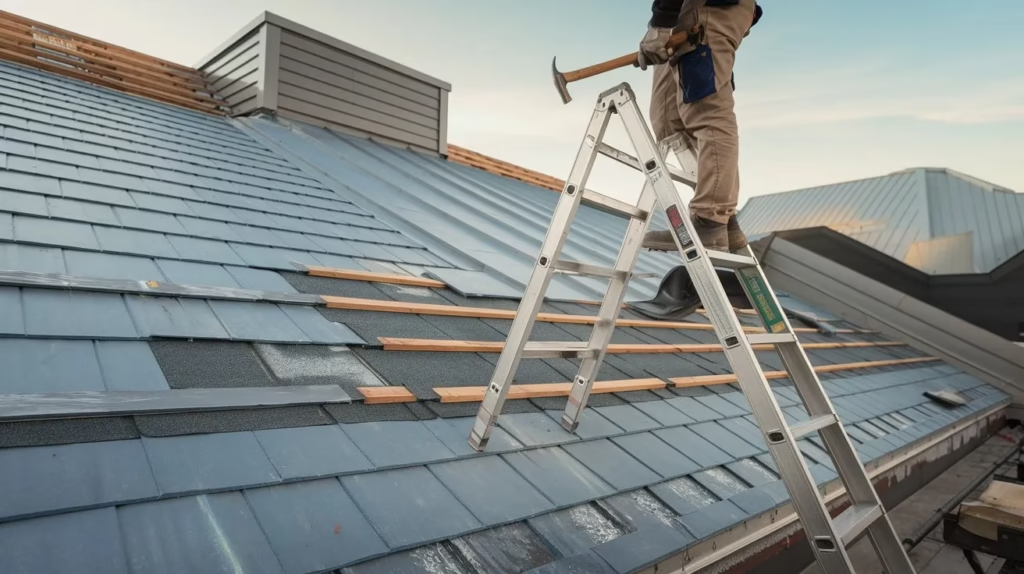
Sometimes, a full roof replacement might not be necessary. Understanding when to repair versus when to replace can save you significant money and hassle.
Signs You Should Repair Your Roof
- Your roof is less than 20 years old
- The damage is isolated to a small area
- You have a limited budget
- You’re not planning to sell your home soon
Signs You Should Replace Your Roof
- Your roof is old or nearing the end of its lifespan
- The damage is extensive or widespread
- You’re experiencing frequent leaks or water damage
- You’re planning to sell your home soon
Consider getting a professional inspection if you’re unsure whether repair or replacement is the best option for your situation.
Choosing the Right Professionals
Selecting the right roofing contractor is crucial for ensuring a successful and long-lasting roof replacement. Here are key factors to consider:
- Contractor Experience and Reputation
Look for contractors with a proven track record in your specific type of roofing project. - Customer Reviews
Read online reviews and ask for references from past clients. - Referrals From People You Trust
Personal recommendations can be invaluable in finding a reliable contractor. - Warranty Offerings
A reputable contractor should offer warranties on both materials and workmanship. - Years in Business
Established companies are more likely to be around to honor long-term warranties. - Proper Licensing and Insurance
Ensure the contractor is licensed in your state and carries adequate insurance coverage. - Written Estimates
Get detailed, written estimates from multiple contractors to compare.
Estimating and Budgeting for Roof Replacement
Proper planning and budgeting are essential for a successful roof replacement project. Here are some strategies to help you estimate and budget effectively:
Roof Replacement Cost Calculator
Utilize online roof replacement cost calculators to get a rough estimate. These tools typically factor in your roof size, material choice, and location to provide a ballpark figure.
Factors to Consider When Estimating Cost
Remember to account for all the factors we’ve discussed, including material costs, labor, roof complexity, and additional expenses like permits and clean-up.
Financing Options for Roof Replacement
- Home equity loans or lines of credit
- FHA Title I loans for home improvements
- Contractor financing programs
- Personal loans or credit cards (as a last resort)
Budgeting Tips for Roof Replacement in 2025
- Start saving early
- Get multiple quotes
- Set aside 10-20% extra for unexpected expenses
- Research potential tax credits or rebates for energy-efficient roofing options
- Consider the long-term value and not just the upfront cost
Getting the Best Value for Your Roof Replacement
To ensure you’re getting the best value for your investment, consider these strategies:
- Explore Homeowners Insurance Claim Options
If your roof damage is due to a covered event (like severe weather), your insurance might cover part or all of the replacement cost. - Get Three to Five Quotes
Obtaining multiple quotes allows you to compare prices and services offered by different contractors. - Pick the Right Season
Scheduling your roof replacement during the off-season (typically late winter or early spring) may result in better pricing and availability. - Analyze Quotes Thoroughly
Look beyond the bottom line to understand what’s included in each quote, such as materials, labor, warranties, and additional services. - Negotiate for Better Pricing
Don’t be afraid to negotiate with contractors, especially if you have multiple competitive quotes. - Consider Energy Efficiency
Investing in energy-efficient roofing materials may cost more upfront but can lead to significant savings on energy bills over time. - Understand the Warranty
A good warranty can provide peace of mind and potentially save you money on future repairs or replacements.
Conclusion
Understanding the factors that influence roof replacement costs in 2025 is crucial for making informed decisions and getting the best value for your investment. By considering all aspects – from material choices to contractor selection – and planning carefully, you can ensure a successful roof replacement that protects your home for years to come.
Remember, while cost is important, the quality of materials and workmanship should be your top priority to ensure the longevity and performance of your new roof. A well-executed roof replacement not only protects your home from the elements but can also improve its energy efficiency, enhance its curb appeal, and increase its overall value.
As you embark on your roof replacement journey, take the time to research your options, consult with multiple professionals, and carefully consider your long-term needs. With proper planning and informed decision-making, you can navigate the complexities of roof replacement and emerge with a durable, beautiful roof that will serve you well for decades to come.

